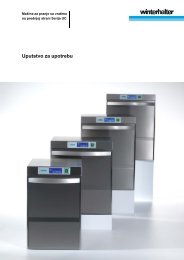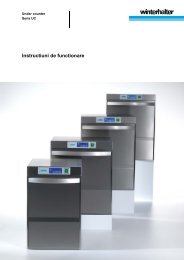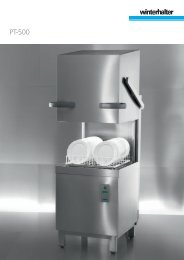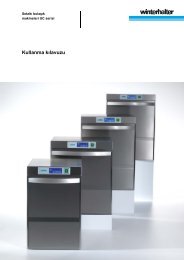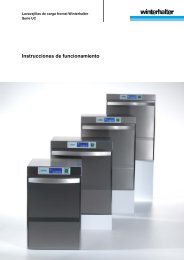Bedienungsanleitung Analysekoffer Chemie / Wasser - Winterhalter
Bedienungsanleitung Analysekoffer Chemie / Wasser - Winterhalter
Bedienungsanleitung Analysekoffer Chemie / Wasser - Winterhalter
Create successful ePaper yourself
Turn your PDF publications into a flip-book with our unique Google optimized e-Paper software.
GB<br />
Instruction manual for Chemistry /<br />
Water Analysis Kit (30 000 320)<br />
1. Determining detergent residues on dishes<br />
Appearance: white/colourless streaks<br />
Required reagents: phenolphthalein (20 000 185)<br />
1. Put a few drops of phenolphthalein on the wet dishes.<br />
2. Alkaline residues, e.g. due to over-concentration of detergents or insufficient<br />
rinsing, show a purple-red colour. Residues of neutral products (e.g.<br />
rinse aids) do not show this reaction.<br />
Warning! Hot, softened water causes a purple-red colour change in association<br />
with phenolphthalein as well, which can simulate detergent residues.<br />
This effect does not occur when letting the dishes cool down to room<br />
temperature before the test. When it comes to dry plates that have<br />
cooled down, it is recommended to drop a few drops of water on<br />
them and add phenolphthalein afterwards. The purple-red colour may<br />
also appear after a few minutes, as the dried detergent residues need<br />
to dissolve in order to show a reaction.<br />
2. pH value measurement<br />
Required reagent: duotest indicator (3202001)<br />
Definition: The pH value measures the concentration of hydrogen ions in<br />
solutions and can be determined by a special ph paper.<br />
1. A pH test swab is dipped in the solution to be tested, and the moistened<br />
area will change its colour. Compare the resulting colours with the colour<br />
scale and the corresponding pH value.<br />
This measurement does not simply determine the concentration of alkaline or<br />
acid products, but it reveals whether a medium is slightly or strongly acidic,<br />
slightly or strongly alkaline or neutral, respectively. Moreover, using the pH test<br />
strip provides information about the type of product which has, for example,<br />
been used into the machine‘s integral chemical containers.<br />
Classification of pH values<br />
1 – 3 strongly acid<br />
4 – 5 slightly acid<br />
6 – 8 neutral<br />
9 – 11 slightly alkaline<br />
12 – 14 strongly alkaline<br />
0 1 2 3 4 5 6 7 8 9 10 11 12 13 14<br />
acid neutral alkaline<br />
pH 7 means: no detergent left inside the machine tank<br />
pH 8 means: not enough detergent inside the machine tank<br />
Determining the pH value does not provide any further information. Titration is<br />
necessary in order to determine the exact detergent concentration inside the<br />
rinse tank!<br />
3. Checking for white and grey coating on dishes<br />
White and grey coating on dishes can be both limescale as well as starch.<br />
3.1 Determining limescale on dishes<br />
Appearance: white/white and grey coating<br />
Required reagent: hydrochloric acid (limestone test solution 20 000 181)<br />
1. Drip several drops of 1 N hydrochloric acid on the coating and observe:<br />
In case of a thick coating, small gas bubbles will emerge, and the quantity<br />
of these bubbles makes the test spot appear white. Upon rinsing the spot<br />
with water, the shining porcelain surface or the white-metal surface of the<br />
steel parts will reappear.<br />
3.2 Determining starch on dishes<br />
Appearance: white/white and grey coating<br />
Required reagent: starch test solution (20 000 184)<br />
1. Drop some of the starch test solution onto a piece of crockery and disperse<br />
the liquid by rocking it. This can also be achieved by further dilution with<br />
water.<br />
2. If the solution changes its colour to deep blue this indicates starch residues.<br />
If the solution changes its colour to yellow, this indicates protein residues.<br />
The reaction is very sensitive. Consequently, a single starch grain in a glaze<br />
scratch can result in a blue spot on the crockery.<br />
Please note that starch grains often stick to calcified surfaces (rough surface).<br />
4. Determining water hardness<br />
Required reagent: water hardness test set (GH: 20 000 187, KH: 20 000 188)<br />
The TH (total hardness) water hardness test set is used for determining the total<br />
water hardness. The CH (carbonate hardness) water hardness test set is used for<br />
determining carbonate hardness.<br />
1. Prior to each water hardness test, the titration cylinder must be carefully<br />
rinsed.<br />
2. Fill up the titration cylinder with the water sample to the 5 ml mark.<br />
3. To measure total hardness, add TH reagent drop by drop until the colour<br />
changes from red to green. Move the titration cylinder slightly after each<br />
drop so that the reagent properly mixes with the water sample. A single<br />
drop of TH reagent corresponds to 1ºdH*.<br />
4. Repeat step 1 and 2 for measuring carbonate hardness.<br />
5. Add drops of CH reagent until the colour changes from blue to green and<br />
lemon yellow. Move the titration cylinder slightly after each drop so that<br />
the reagent properly mixes with the water sample. A single drop of CH reagent<br />
corresponds to 1ºdH*.<br />
Warning! Always keep the flask in a vertical position. Make sure the drops are a<br />
consistent size – only use gentle pressure on the flask.<br />
The carbonate hardness can be as high as the total hardness at most. In the case<br />
of softened water, higher carbonate hardness can be simulated for determination<br />
(e.g. identification of sodium carbonate).<br />
Note:<br />
Determination of hardness does not reveal the total salt<br />
content of the water.<br />
Total salt content: The total salt content of water is determined with the conductometer:<br />
take water sample, remove protective cap, and<br />
place conductometer in the water. The result is displayed in<br />
µSiemens. TH and CH cannot be determined, and have to be<br />
obtained using the water hardness test set.<br />
Conversion: conductivity in µS / 30 = total salt content in °dH*<br />
Using <strong>Winterhalter</strong>‘s water treatments<br />
Items: Water quality Type of water<br />
treatment<br />
Dishes,<br />
devices<br />
Glasses,<br />
dark dishes<br />
Glasses, cutlery<br />
Total hardness (TH)<br />
above 3° dH*<br />
If difference of<br />
total salt content –<br />
CH < 5° dH*<br />
With cutlery rinsing<br />
machines and in if<br />
difference of total salt<br />
content – CH > 5° dH*<br />
ist (for glasses)<br />
Recommendations: glasses: ≤ 150 µS/cm<br />
cutlery: 80 µS/cm<br />
* 1 °dH = 1,78 °fH = 1,25 °e<br />
Softening<br />
Device<br />
Partial demineralisation TE 15<br />
TE 20<br />
Full demineralisation<br />
or reverse osmosis<br />
MonoMatik<br />
DuoMatik<br />
Integrated softener<br />
VE 15<br />
VE 20<br />
RoMatik 150, 160, 210,<br />
420



